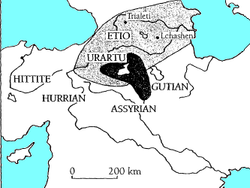Trialeti culture

The territory of the Armenian language appears to have been roughly coincidental with that of the earlier non-IE Hurrian and closely related Urartian (with Dark shading). The poorly known and presumably related non-IE Etio language was to its north. Many of these languages occupied partially or wholly the earlier territory of the Kuro-Araxes culture (light shading). The nearest IE neighbors of the Armenians were the Hittites (and related Luvians and Palaic-speaking populations) who were not closely related to Armenian. Assyrian and Gutian are non IE languages. Burials with wheeled vehicles have been uncovered at Trialeti and Lchashen. [1]
The Trialeti culture was seen around the 2nd millennium B.C.[2] In the late 3rd millennium B.C. settlements of the Kura-Araxes culture began to be replaced by early Trialeti culture sites.[3] The Trialeti culture was the second culture to appear in the Caucasus, after the Kura-Araxes culture.[4] The Trialeti culture shows close ties with the highly-developed cultures of the ancient world, particularly with the Aegean.[5]
Related pages
References
- ↑ “Armenians” in Encyclopedia of Indo-European Culture or EIEC, edited by J. P. Mallory and Douglas Q. Adams, published in 1997 by Fitzroy Dearborn.
- ↑ Munchaev 1994, p. 16; cf., Kushnareva and Chubinishvili 1963, pp. 16 ff.
- ↑ The Making of Bronze Age Eurasia - Page 266 by Philip L. Kohl
- ↑ http://www.drummingnet.com/alekseev/ChapterVIIPart2.html
- ↑ "Trialeti culture". Archived from the original on 2007-09-27. Retrieved 2007-09-28.